Problem
I looking for a way to efficiently order randomly selected sampling transects occur around a fixed object. These transects, once generated, need to be ordered in a way that makes sense spatially such that the distance traveled is minimized. This would be done by ensuring that the end point of the current transect is as close as possible to the start point of the next transect. Also, none of the transects can be repeated.
Because there are thousands of transects to order, and this is a very tedious task to do manually, and I am trying to use R to automate this process. I have already generated the transects, each having a start and end point whose location is indicated using a 360-degree system (e.g., 0 is North, 90 is East, 180 is South, and 270 is West). I have also generated some code that seems to indicate the start point and the ID for the next transect, but there are a few problems with this code: (1) it can generate errors depending on the start and end points being considered, (2) it doesn't achieve what I ultimately need it to achieve, and (3) as is, the code itself seems overly complicated and I can't help but wonder if there is a more straightforward way to do this.
Ideally, the code would result in the transects being reordered such they match the order that they should be flown rather than the order that they were initially input.
The Data
For simplicity, let's pretend there are just 10 transects to order.
# Transect ID for the start point
StID <- c(seq(1, 10, 1))
# Location of transect start point, based on a 360-degree circle
StPt <- c(342.1, 189.3, 116.5, 67.9, 72, 208.4, 173.2, 97.8, 168.7, 138.2)
# Transect ID for the end point
EndID <- c(seq(1, 10, 1))
# Location of transect start point, based on a 360-degree circle
EndPt <- c(122.3, 313.9, 198.7, 160.4, 166, 26.7, 312.7, 273.7, 288.8, 287.5)
# Dataframe
df <- cbind.data.frame(StPt, StID, EndPt, EndID)
What I Have Tried
Please feel free to ignore this code, there has to be a better way and it does not really achieve the intended outcome. Right now I am using a nested for-loop that is very difficult to intuitively follow but represents my best attempt thus far.
# Create two new columns that will be populated using a loop
df$StPt_Next <- NA
df$ID_Next <- NA
# Also create a list to be populated as end and start points are matched
used <- c(df$StPt[1]) #puts the start point of transect #1 into the used vector since we will start with 1 and do not want to have it used again
# Then, for every row in the dataframe...
for (i in seq(1,length(df$EndPt)-1, 1)){ # Selects all rows except the last one as the last transect should have no "next" transect
# generate some print statements to indicate that the script is indeed running while you wait....
print(paste("######## ENDPOINT", i, ":", df$EndPt[i], " ########"))
print(paste("searching for a start point that fits criteria to follow this endpoint",sep=""))
# sequentially select each end point
valueEndPt <- df[i,1]
# and order the index by taking the absolute difference of end and start points and, if this value is greater than 180, also subtract from 360 so all differences are less than 180, then order differences from smallest to largest
orderx <- order(ifelse(360-abs(df$StPt-valueEndPt) > 180,
abs(df$StPt-valueEndPt),
360-abs(df$StPt-valueEndPt)))
tmp <- as.data.frame(orderx)
# specify index value
index=1
# for as long as there is an "NA" present in the StPt_Next created before for loop...
while (is.na(df$StPt_Next[i])) {
#select the value of the ordered index in sequential order
j=orderx[index]
# if the start point associated with a given index is present in the list of used values...
if (df$StPt[j] %in% used){
# then have R print a statement indicate this is the case...
print(paste("passing ",df$StPt[j], " as it has already been used",sep=""))
# and move onto the next index
index=index+1
# break statement intended to skip the remainder of the code for values that have already been used
next
# if the start point associated with a given index is not present in the list of used values...
} else {
# then identify the start point value associated with that index ID...
valueStPt <- df$StPt[j]
# and have R print a statement indicating an attempt is being made to use the next value
print(paste("trying ",df$StPt[j],sep=""))
# if the end transect number is different from the start end transect number...
if (df$EndID[i] != df$StID[j]) {
# then put the start point in the new column...
df$StPt_Next[i] <- df$StPt[j]
# note which record this start point came from for ease of reference/troubleshooting...
df$ID_Next[i] <- j
# have R print a statement that indicates a value for the new column has beed selected...
print(paste("using ",df$StPt[j],sep=""))
# and add that start point to the list of used ones
used <- c(used,df$StPt[j])
# otherwise, if the end transect number matches the start end transect number...
} else {
# keep NA in this column and try again
df$StPt_Next[i] <- NA
# and indicate that this particular matched pair can not be used
print(paste("cant use ",valueStPt," as the column EndID (related to index in EndPt) and StID (related to index in StPt) values are matching",sep=""))
}# end if else statement to ensure that start and end points come from different transects
# and move onto the next index
index=index+1
}# end if else statement to determine if a given start point still needs to be used
}# end while loop to identify if there are still NA's in the new column
}# end for loop
The Output
When the code does not produce an explicit error, such as for the example data provided, the output is as follows:
StPt StID EndPt EndID StPt_Next ID_Next
1 342.1 1 122.3 1 67.9 4
2 189.3 2 313.9 2 173.2 7
3 116.5 3 198.7 3 97.8 8
4 67.9 4 160.4 4 72.0 5
5 72.0 5 166.0 5 116.5 3
6 208.4 6 26.7 6 189.3 2
7 173.2 7 312.7 7 168.7 9
8 97.8 8 273.7 8 138.2 10
9 168.7 9 288.8 9 208.4 6
10 138.2 10 287.5 10 NA NA
The last two columns were generated by the code and added to the original dataframe. StPt_Next has the location of the next closest start point and ID_Next indicates the transectID associated with that next start point location. The ID_Next column indicates that the order transects should be flown is as follows 1,4,5,3,8,10,NA (aka. the end), and 2,7,9,6 form their own loop that goes back to 2.
There are two specific problems that I can't solve:
(1) There is a problem of forming one continuous chain of sequence. I think this is related to having 1 be the starting transect and 10 being the last transect no matter what, but not knowing how to indicate in the code that the second to last transect must match up with 10 so that the sequence includes all 10 transects before terminating at an "NA" representing the final end point.
(2) To really automate this process, after fixing the early termination of the sequence due to the premature introduction of the "NA" as the ID_next, a new column would be made that would allow the transects to be reordered based on the most efficient progression rather than the original order of their EndID/StartID.
Intended Outcome
If we pretend that we only had 6 transects to order and ignore the 4 that were not able to be ordered due to the premature introduction of the "NA", this would be the intended outcome:
StPt StID EndPt EndID StPt_Next ID_Next TransNum
1 342.1 1 122.3 1 67.9 4 1
4 67.9 4 160.4 4 72.0 5 2
5 72.0 5 166.0 5 116.5 3 3
3 116.5 3 198.7 3 97.8 8 4
8 97.8 8 273.7 8 138.2 10 5
10 138.2 10 287.5 10 NA NA 6
EDIT: A Note About the Error Message Explicitly Produced by the Code
As indicated earlier, the code has a few flaws. Another flaw is that it will often produce an error when trying to order a larger number of transects. I am not entirely sure at what step in the process the error is generated, but I am guessing that it is related to the inability to match up the last few transects, possibly due to not meeting the criteria set forth by "orderx". The print statements say "trying NA" instead of a start point in the database, which results in this error: "Error in if (df$EndID[i] != df$StID[j]) { : missing value where TRUE/FALSE needed". I am guessing that there would need to be another if-else statement that somehow indicates "if the remaining points do not meet the orderx criteria, then just force them to match up with whatever transect remains so that everything is assigned a StPt_Next and ID_Next".
Here is a larger dataset that will generate the error:
EndPt <- c(158.7,245.1,187.1,298.2,346.8,317.2,74.5,274.2,153.4,246.7,193.6,302.3,6.8,359.1,235.4,134.5,111.2,240.5,359.2,121.3,224.5,212.6,155.1,353.1,181.7,334,249.3,43.9,38.5,75.7,344.3,45.1,285.7,155.5,183.8,60.6,301,132.1,75.9,112,342.1,302.1,288.1,47.4,331.3,3.4,185.3,62,323.7,188,313.1,171.6,187.6,291.4,19.2,210.3,93.3,24.8,83.1,193.8,112.7,204.3,223.3,210.7,201.2,41.3,79.7,175.4,260.7,279.5,82.4,200.2,254.2,228.9,1.4,299.9,102.7,123.7,172.9,23.2,207.3,320.1,344.6,39.9,223.8,106.6,156.6,45.7,236.3,98.1,337.2,296.1,194,307.1,86.6,65.5,86.6,296.4,94.7,279.9)
StPt <- c(56.3,158.1,82.4,185.5,243.9,195.6,335,167,39.4,151.7,99.8,177.2,246.8,266.1,118.2,358.6,357.9,99.6,209.9,342.8,106.5,86.4,35.7,200.6,65.6,212.5,159.1,297,285.9,300.9,177,245.2,153.1,8.1,76.5,322.4,190.8,35.2,342.6,8.8,244.6,202,176.2,308.3,184.2,267.2,26.6,293.8,167.3,30.5,176,74.3,96.9,186.7,288.2,62.6,331.4,254.7,324.1,73.4,16.4,64,110.9,74.4,69.8,298.8,336.6,58.8,170.1,173.2,330.8,92.6,129.2,124.7,262.3,140.4,321.2,34,79.5,263,66.4,172.8,205.5,288,98.5,335.2,38.7,289.7,112.7,350.7,243.2,185.4,63.9,170.3,326.3,322.9,320.6,199.2,287.1,158.1)
EndID <- c(seq(1, 100, 1))
StID <- c(seq(1, 100, 1))
df <- cbind.data.frame(StPt, StID, EndPt, EndID)
Any advice would be greatly appreciated!


